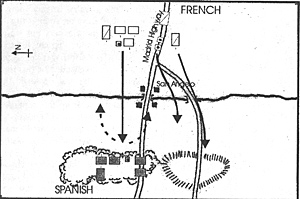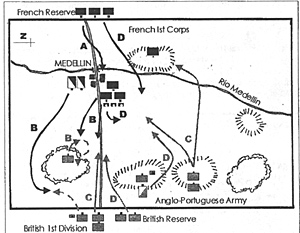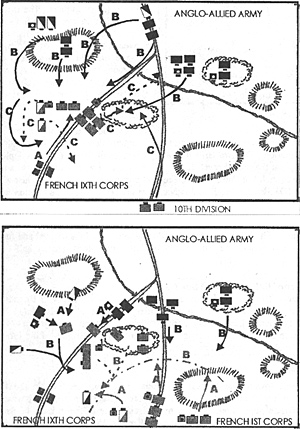Campaign Moves, April 1-14, 1809
With the Spanish Army of the Left defeated again, the only effective Spanish force was the Army of Right operating in the vicinity of Madrid. The French Ist and Vth Corps, moving slowly through the mountain passes east of the Spanish capitol, are slowly closing in. At the same time, the French IXth Corps, which had been occupying Murcia, abandons that provincial capitol to confront the British army threatening its line of communications. The British force, under the command of General Lord Underhill, retraces its steps to Madrid. In the second week of February the French 1st and Vth Corps advance against Madrid. The remnants of the Spanish Army of the Right, expecting the arrival of Underhill's British army, take up a strong defensive position east of Madrid near the town of San Angelo.
 Battle of San Angelo, April 8,1809
Battle of San Angelo, April 8,1809
Spanish General Blanco's Army of the Right, with 9,500 men and 8 guns, takes up position in the woods west of San Angelo covering the road to Madrid. General Marche, commanding the French Ist Corps in the absence of Marshal Ardant, recalled to Bayonne to receive his baton, deploys more than 8,000 men with 24 guns. Aware that the British army is in the vicinity, Marche decides not to await the arrival of the Vth Corps, determining to smash the Spanish before the British can intervene. His battle plan is simple - based on his previous experience fighting the Spanish he will charge straight ahead and destroy them.
Forming his three infantry brigades into attack columns screened by skirmishers and protected on the right flank by cavalry, Marche moves quickly over the stream and up to the Spanish position. His advance is so rapid that his artillery has no time to come into effective action. The French commander quickly loses control of the situation and sends his infantry against the woods piecemeal. Much to his surprise the Spanish, fighting from the cover of the woods and protecting their capitol, throw back his first attacks with heavy loss. Reforming his infantry he leads them forward again, only to be repulsed again. Attempting to rally his demoralized forces Marche is struck by a cannonball and killed instantly. Already disconcerted by the unexpected resistance of the Spanish the French troops panic at the death of their leader and stampede to the rear, ignoring the attempts of the French officers to stem the tide. The surprised Spanish move to pursue but are able to do no more than capture a battery of French guns trapped against the stream. The Spanish army inflicts a total of 2500 casualties on the French and capture 8 guns, losing just 500 men themselves. The Ist Corps is driven back into the mountains northeast of Madrid. The French Vth Corps is unable to link up with the Ist Corps and the British army is also fails to make an appearance.
Battle of San Angelo OOB
Spanish Army of the Right (18 AP), 1 General (Average), 1 Lieutenant, 4 Brigades Conscript Infantry, 1 Brigade Conscript Cavalry, 1 Battery Foot Artillery
French Ist Corps (33 AP), 1 General (Inferior), 1 Lieutenant, 1 Brigade Light Infantry, 2 Brigades Line Infantry, 1 Brigade Heavy Cavalry, 2 Brigades Light Cavalry, 1 Battery Horse Artillery, 2 Batteries Foot Artillery.
Campaign Moves, April 15-21, 1809
Infuriated by the defeat of his Corps, Marshal Ardant rushes back to rally his demoralized force and leads them southwest again to link up with the Vth Corps. By this time, however, General Lord Underhill has returned to the vicinity of Madrid and moves to engage the Vth Corps. Ordering his shaken Ist Corps to follow, Marshal Ardant rides to assume personal command in what may prove to be the most critical battle of the campaign.
The Ist Corps is moving to effect the planned link-up when scouts report the approach of the Spanish Army of the Right. General Blanco's army, fresh off its recent victory and reinforced by thousands of enthusiastic volunteers moves to protect the left flank of the British Army. At the same time, General Rohan's lXth Corps is approaching Madrid from the southeast but has not crossed the Tagus River. While the Spanish Army of the Right and the French Ist Corps maneuver Marshal Ardant's Vth Corps meets the British army in the Battle of Medellin.
 Battle of Medellin, April 17, 1809
Battle of Medellin, April 17, 1809
Expecting that he will be outnumbered until the arrival of the British 151 Division General Lord Underhill determines to stand on the defensive. Placing a light infantry brigade in the forest guarding his left flank he deploys three brigades of British and Portuguese Line infantry on the reverse slope of the two hills south of Medellin, supported by an artillery battery and light cavalry brigade. Two additional infantry brigades, one British and one Portuguese are held in reserve behind the left flank where the 1st Division is scheduled to deploy. At this point Lord Underhill forces number almost 14,000 with 8 guns. Another 6,500 and 8 guns are in the 1st Divison.
Due to the importance of this battle, and because he is encountering the British for the first time, Marshal Ardant moves cautiously. With 17,000 men and 24 guns available he knows that he outnumbers the enemy on the field but is aware of the British division that might arrive at an inconvenient time and place. Forming his 24 guns into a Grand Battery supported by three brigades of infantry and two of cavalry he moves his attack force through Medellin. A single infantry brigade is deployed to protect his left flank and three infantry brigades are held in reserve to counter the expected British reinforcements.
(A) The battle begins at 10 AM as Marshal Ardant deploys his Grand Battery facing the hills backed up by a brigade of cavalry. Although it has no immediate target, due to the British use of reverse slopes, it dominates the gap through which the Medellin Road runs.
(B) The French infantry probes toward the North Woods drawing a countercharge by the British light infantry stationed there. The British are repulsed but their presence threatens the flank of the French force, halting their movement forward. Ardant swings a brigade of light cavalry north around the woods to cut off the escape route of the British light infantry.
(C) At 12 PM the British 1st Division arrives and deploys on the battlefield. A Portuguese infantry brigade and British battery move to confront the French light horse on the French right flank. Forming square and advancing the Portuguese drive the French cavalry back while the battery knocks holes in their formation. The two British infantry brigades of the I81 Division deploy into line and advance up the Medellin Road against the main French force. At the same time, Lord Underhill advances two brigades from the hills to threaten the French left flank. This piecemeal commitment of forces is just what the French commander has been waiting for.
(D) Slowing the British advance in the center using his infantry Marshal Ardant pivots his Grand Battery and blasts the nearer of the Allied flanking brigades. Although the British light cavalry brigade moves to their support the fire is too much and the brigade routs. Ardant then deploys his reserve to contain the remaining brigade and support his grand battery, which pivots again to face the main British threat. The British in the center are able to push the French back but they are taking heavy casualties from the French artillery and small arms fire. Lord Underhill is forced to commit his remaining reserve of two infantry brigades to bolster his center. By 3 PM, Underhill knows the battle is lost and decides to retreat, using his reserve and cavalry as a rear guard. Although he is able to withdraw most of his remaining forces, a Portuguese brigade is trapped and forced to surrender. The Allied army is able to break contact but suffers almost 5,000 casualties, almost half of them captured. French losses are less than 1,000.
Order of Battle, Battle of San Medellin OOB
Anglo-Portuguese Army (31 AP), 1 General (Inferior), 2 Lieutenants, 1 Brigade Light Infantry, 5 Brigades Line Infantry (2 Portuguese), 1 Brigade Light Cavalry, 1 Battery Foot Artillery, British 1st Division (15 AP), 1 Lieutenant, 3 Brigades Line Infantry (1 Portuguese), 1 Battery Foot Artillery
French Ist Corps (47 AP), 1 General (Average), 3 Lieutenants, 1 Brigade Elite Infantry, 1 Brigade Light Infantry, 5 Brigades Line Infantry, 1 Brigade Heavy Cavalry, 1 Brigade Light Cavalry, 3 Batteries Foot Artillery.
Campaign Moves, April 22 - June 7, 1089
The defeated British army withdraws west toward the fortress of Ciudad Rodrigo. Isolated in the face of overwhelming French numerical superiority the Spanish Army of the Center is forced into Madrid where it is quickly surrounded and besieged. The civilian population, inspired by the resistance of the citizens of Saragosa, demands a fight to the death but General Blanco, ill with fever and demoralized by the withdrawal of the British, surrenders the city on April 28, 1809. Almost 20,000 Spanish soldiers pass into captivity without a shot being fired.
The French occupation is short-lived, however, as the news of the fall of Madrid enrages the countryside. Numerous partisan bands spring into being in the mountains north and east of Madrid cutting the tenuous French supply lines. By mid-May Marshal Ardant abandons the capitol temporarily and moves to reopen communications with France. As the Spanish struggle to organize a new field force the British First Army, now under the command of General Henry Doyle, moves to hold Madrid for the allies. French General Rohan's IXth Corps, with secure lines of communication running back to Valencia, is still operating in New Castille south of the Tagus River. In late May General Rohan moves north to again threaten Madrid while Marshal Ardant's Ist Corps, whose supply line is now well guarded, attacks from the east.
 Battle of Torres Grande, June 1, 1809
Battle of Torres Grande, June 1, 1809
The British First Army, under the command of General Henry Doyle, is forced to accept battle as the French Ist and IXth Corps converge on his location. Doyle's army of 22,000 men and 24 guns takes up position north and west of the Torres River, southeast of Madrid. General Rohan's IXth Corps, 14,500 men and 16 guns moves north from the town of Torres Grande to engage the British Army anticipating the arrival of the Marshal Ardant's Ist Corps on his right flank. General Rohan's lOa' Division of 4,000 men is held in reserve.
r First Phase - (A) General Rohan advances directly up the Banderas Road to threaten the western bridge over the Banderas River.
(B) General Doyle responds by deploying five brigades of British and Portuguese infantry supported by a battery across the river, sending three to contest the woods and the other two to protect the western bridge. At the same time two British infantry and three British Cavalry Brigades, supported by another battery advance from the hill to threaten the French left flank. The British cavalry charge and engage the two French cavalry brigades, driving them back.
(C) The French cavalry is unable to rally and a brigade of French converged grenadiers is forced into square and then destroyed by British artillery and musketry. The French left, deprived of cavalry support, is turned and threatened by the victorious British cavalry. General Rohan deploys his l0"' Division and by 12PM is able to drive the British forces out of the western woods although both sides suffer heavy losses
Second Phase - By 12:30PM the French IXth Corps is in desperate condition. Two cavalry brigades, an infantry brigade, and an artillery battery have been destroyed and two other infantry brigades are wavering and isolated, As the Ist Corps begins to deploy on the field the British launch a fierce attack on the hinge of the French line (A), eliminating two more brigades and breaking the morale of the IXth Corps. At the same time the French Ist Corps deploys and attacks the far right flank British cavalry brigade, driving it from the field. As the lXth Corps attempts to break contact (B) the Ist Corps establishes a perimeter (B) and the British army advances on all fronts
Although the British have suffered substantial casualties General Ardant decides the odds are against him and chooses to withdraw his corps. The British pursuit is halted by strong rearguard actions and by 1:30 PM the French withdrawal is successful. The French army suffered more than 6100 killed and captured, most from the IXth Corps while the British/Portuguese lose 2900 killed and captured. The IXth Corps withdraws along its line of communication across the Tagus River while the Ist Corps withdraws east into the mountains.
Order of Battle, Battle of Torres Grande OOB
Anglo-Portuguese First Army (60 AP), 1 General (Superior), 4 Lieutenants, 1 Brigade Elite Infantry, 2 Brigades Light Infantry (1 Portuguese), 6 Brigades Line Infantry (2 Portuguese), 1 Brigade Heavy Cavalry, 2 Brigades Light Cavalry, 1 Battery Horse Artillery, 2 Batteries Foot
French IXth Corps (39 AP), 1 General (Superior), 2 Lieutenants, 1 Brigade Elite Infantry, I Brigade Light Infantry, 4 Brigades Line Infantry, 2 Brigades Light Cavalry, 2 Batteries Foot Artillery, French 10th Division (7 AP) I Lieutenant, 1 Brigade Light Infantry, 1 Brigade Line Infantry, French Ist Corps (34 AP), 1 General (Superior), 2 Lieutenants, 1 Brigade Light Infantry, 4 Brigades Line Infantry, 1 Brigade Light Cavalry, 1 Battery Horse Artillery, 2 Batteries Foot Artillery
Campaign Moves, June 8 - 28, 1809 and Summary
The campaign month of June ends with the French consolidating their positions and the British and Spanish building up their forces around Madrid.
The campaign lasted for 8 game months (32 turns) and generated 8 corps sized battles. Six of the battles were French victories, five against Spanish armies and one against the British. The Spanish won one battle, San Angelo, and the British won at Tones Grande. The campaign recreated the historical situation in the Peninsular War quite well with the French smashing the Spanish armies but suffering losses due to partisans that forced them to detach large forces to protect their lines of supply. The two French players, who had different objectives and competed for resources, rarely cooperated with each other, which also mirrored the historical campaign. The Spanish player learned the hard way just how brittle and difficult to maneuver were armies made up mostly of conscripts and the British player, mindful of the value of his army, moved cautiously. Everyone enjoyed the battles and even the campaign game took on a separate life that all enjoyed.
The most satisfying aspect of the campaign, however, was its effect on the battles fought. The limited reconnaissance and battlefield concentration rules of the campaign game combined with hidden deployment and use of flank marches and reserves of the battle rules to generate a tremendous "fog of war". A good example was the Battle of Tres Puentes. The Spanish commander was very hesitant throughout the battle, in spite of his overwhelming superiority, and allowed the French to use their superior morale and command assets to shift forces and meet each Spanish move. After the battle the Spanish player admitted that he was sure that the French player had an off-board reserve or flank march coming - he just could not believe that the French force was so small.
A Peninsula War Campaign Nov 1808-Jun 1809 Fought Using Le Petit Armee Rules and Campaign Rules
- Introduction
Campaign Moves (Nov-Dec 1808)
Campaign Moves (Dec 1808 - March 1809)
Campaign Moves (April - June 1809)
Back to MWAN # 124 Table of Contents
Back to MWAN List of Issues
Back to MagWeb Magazine List
© Copyright 2003 Hal Thinglum
This article appears in MagWeb.com (Magazine Web) on the Internet World Wide Web.
Other articles from military history and related magazines are available at http://www.magweb.com